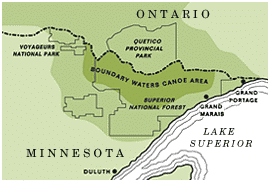Four developed campsites and four undeveloped areas in Voyageurs National Park that were off-limits due to bald eagles nesting have been re-opened, the Park announced recently.
The Sexton Island campsite on Namakan Lake, the Sand Bay South houseboat site on Rainy Lake, and the Feedem Island and Yoder Island houseboat sites on Kabetogama Lake are now open to visitor use. Voyageurs National Park has a total of 239 campsites spread across the 218,000 acre park.
The re-opened undeveloped areas are: West Sphunge Island Inlet, North Wood Duck Island, and West Harris Island Point on Kabetogama Lake and the North Diamond Island undesignated houseboat site on Rainy Lake.
The closures were necessitated by the park’s obligation to follow the conservation management rules of the federal Bald Eagle and Golden Eagle Management Act. Each year since 1992, the park has temporarily closed to visitor use the land and water areas around active bald eagle nests during their critical nesting periods.
Voyageurs National Park biologists found 74 nests within the park boundary this breeding season. Three nests observed in 2010 were gone this year either because nest trees blew down or nests fell from nest trees. One new nest each was found on Kabetogama, Rainy and Sand Point Lakes for a total of three new nests.
Adults were observed incubating at 36 nests compared to 33 in 2010, 38 in 2009, 30 in 2006, 26 in 2004 and 2005, and 20 pairs in 1999. Incubation occurred at 1 park nest on Crane Lake, 1 on an interior lake, 14 on Kabetogama Lake, 8 on Namakan Lake, 9 on Rainy Lake and 3 on Sandpoint Lake.
Park officials calculate that 28 young eagles fledged this year.
Read Voyageurs full media release on the re-openings and eagle nesting statistics HERE.

